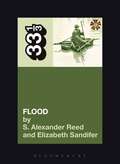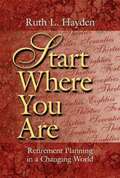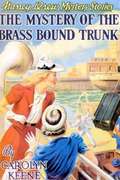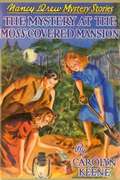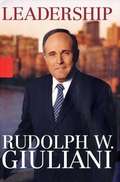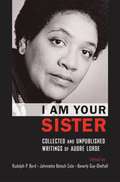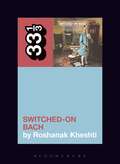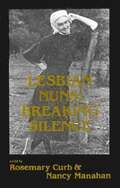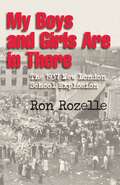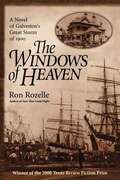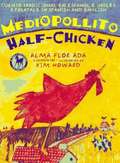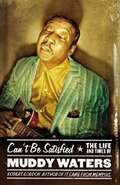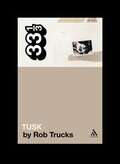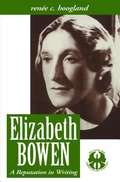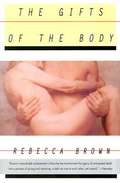- Table View
- List View
They Might Be Giants' Flood (33 1/3 Ser. #88)
by S. Alexander Reed Elizabeth SandiferFor a few decades now, They Might Be Giants’ album Flood has been a beacon (or at least a nightlight) for people who might rather read than rock out, who are more often called clever than cool. Neither the band’s hip origins in the Lower East Side scene nor Flood’s platinum certification can cover up the record’s singular importance at the geek fringes of culture. Flood’s significance to this audience helps us understand a certain way of being: it shows that geek identity doesn’t depend on references to Hobbits or Spock ears, but can instead be a set of creative and interpretive practices marked by playful excess—a flood of ideas. The album also clarifies a historical moment. The brainy sort of kids who listened to They Might Be Giants saw their own cultural options grow explosively during the late 1980s and early 1990s amid the early tech boom and America’s advancing leftist social tides. Whether or not it was the band’s intention, Flood’s jubilant proclamation of an identity unconcerned with coolness found an ideal audience at an ideal turning point. This book tells the story.
Start Where You Are: Retirement Planning in a Changing World
by Ruth L. HaydenStart where You Are is a delight to read. It’s like sitting down with Ruth and carrying on a warm, lively conversation about ways to transform dreams into reality and bring balance into life, and to take control of our finances. Ruth offers plenty of sensible, no nonsense advice for managing money through the ages. But her passion is helping you create a vision and a realistic plan for achieving the kind of life you want, especially during your later years. Do you want to start mapping out your blueprint for a good retirement? Then I highly recommend Start Where You Are. Chris Farrell, host of Public Television’s Right on the Money and Public Radio’s Sound Money Far from another personal finance tome, Ruth Hayden's book is an inspiring and highly entertaining guide to planning for the rest of your life, however long that may be. While it offers clear guidance in terms of helping readers understand how much money they’ll need in retirement and how to make it last, it goes far beyond that—provoking us to think about what we really want for our lives. The real-life stories she relates make this a very readable hook. Gerri Detweiler, consumer advocate and author of The Ultimate Credit Handbook
The Mystery Of The Brass Bound Trunk (Nancy Drew Mystery Stories #17)
by Carolyn Keene Russell H. TandyA trunk that Nancy receives from her father for a trip to Buenos Aires becomes the center of a mystery. Beginning in the late 1950s, the Nancy Drew books were revised and condensed. This is the version published in 1934, before the changes.
The Mystery Of The Moss-Covered Mansion (Nancy Drew Mystery Stories #18)
by Carolyn Keene Russell H. TandyWhy is the moss covered mansion so fiercely guarded by the red bearded man and what are the horrible sounds coming from there? And, can Nancy help her dad find a missing heiress? Join Nancy Drew along with Bess Marvin and George Fayne as they help the famous lawyer, Carson Drew, locate a missing heiress, uncover multiple crimes, and reunite long lost friends. This is the original story lines, not to be confused with later condensed, updated versions. This eighteenth book in the Nancy Drew series was originally published in 1941. In the late 1950s, the Nancy Drew books were revised and condensed. This is the version published before the revisions.
Leadership
by Ken Kurson Rudolph W. GiulianiHaving inherited a city ravaged by crime and crippled in its ability to serve its citizens, Giuliani shows how he found that every aspect of his career up to that point-from clerking for the formidable judge who demanded excellence (and rewarded it with a lifetime of loyalty) to busting organized crime during his years as a federal attorney -shaped his thinking about leadership and prepared him for the daunting challenges ahead. Giuliani's successes in turn strengthened his conviction about the core qualities required to be an effective leader, no matter what the size of the organization, be it an international corporation or a baseball team. In detailing his principles of leadership, Giuliani tells captivating stories that are personal as well as prescriptive.
I Am Your Sister: Collected and Unpublished Writings of Audre Lorde
by Rudolph P. Byrd Johnnetta Betsch Cole Beverly Guy-SheftallAudre Lorde was not only a famous poet; she was also one of the most important radical black feminists of the past century. Her writings and speeches grappled with an impressive broad list of topics, including sexuality, race, gender, class, disease, the arts, parenting, and resistance, and they have served as a transformative and important foundation for theorists and activists in considering questions of power and social justice. Lorde embraced difference, and at each turn she emphasized the importance of using it to build shared strength among marginalized communities. I Am Your Sister is a collection of Lorde's non-fiction prose, written between 1976 and 1990, and it introduces new perspectives on the depth and range of Lorde's intellectual interests and her commitments to progressive social change. Presented here, for the first time in print, is a major body of Lorde's speeches and essays, along with the complete text of A Burst of Light and Lorde's landmark prose works Sister Outsider and The Cancer Journals. Together, these writings reveal Lorde's commitment to a radical course of thought and action, situating her works within the women's, gay and lesbian, and African American Civil Rights movements. They also place her within a continuum of black feminists, from Sojourner Truth, to Anna Julia Cooper, Amy Jacques Garvey, Lorraine Hansberry, and Patricia Hill Collins. I Am Your Sister concludes with personal reflections from Alice Walker, Gloria Joseph, Johnnetta Betsch Cole, Beverly Guy-Sheftall, and bell hooks on Lorde's political and social commitments and the indelibility of her writings for all who are committed to a more equitable society.
Wendy Carlos's Switched-on Bach (33 1/3 Ser. #141)
by Roshanak KheshtiSo much, popular and scholarly, has been written about the synthesizer, Bob Moog, and his brand-name instrument-and even Wendy Carlos, the musician who made this instrument famous. No one, however, has examined the importance of spy technology, the Cold War, and gender to this critically important innovation. What is the relationship between synthesizers, electronic music, and world politics? These unlikely correlations form the backdrop to Roshanak Kheshti's inquiry into Wendy Carlos's award-winning album. Through a postcolonial, feminist science and technology studies perspective, Kheshti explores the importance of Carlos's first album to synthesizer technology, home studio design, and sound color orchestration. She further examines the jockeying among world powers for status within an electronic music race akin to the Space Race of the same era. By focusing on Switched-On Bach (the highest-selling classical music recording of all time), this book examines the gendering of sound over the course of the twentieth century. Roshanak Kheshi is Associate Professor of Ethnic Studies and affiliate faculty in the Critical Gender Studies Program at the University of California, San Diego, USA.
Lesbian Nuns: Breaking Silence
by Rosemary Curb Nancy ManahanIn these unique and compelling revelations, both ex-nuns and present nuns unlock the most secret doors in their closed and mysterious communities. Under rigidly enforced rules of behavior, where women's lives are consecrated and subjugated to the most sacred of vows, where "particular friendships" are ruthlessly eradicated under pain of sin and expulsion, still the power of love manages to emerge and survive. Each nun in these stories describes the infividual and searing path she has journeyed to discover and face and experience the truth of herself: that she is a Lesbian nun.
My Boys and Girls Are in There: The 1937 New London School Explosion
by Ron RozelleOn March 18, 1937, a spark ignited a vast pool of natural gas that had collected beneath the school building in New London, a tiny community in East Texas. The resulting explosion leveled the four-year-old structure and resulted in a death toll of more than three hundred—most of them children. To this day, it is the worst school disaster in the history of the United States. The tragedy and its aftermath were the first big stories covered by Walter Cronkite, then a young wire service reporter stationed in Dallas. He would later say that no war story he ever covered—during World War II or Vietnam—was as heart-wrenching. In the weeks following the tragedy, a factfinding committee sought to determine who was to blame. What soon became apparent was that the New London school district had, with almost all local businesses and residents, tapped into pipelines carrying unrefined gas from the plentiful oil fields of the area. It was technically illegal, but natural gas was in abundance in the “Oil Patch.” The jerry-rigged conduits leaked the odorless “green” gas that would destroy the school. A long-term effect of the disaster was the shared guilt experienced—for the rest of their lives—by most of the survivors. There is, perhaps, not a better example than Bill Thompson, who was in his fifth grade English class and “in the mood to flirt” with Billie Sue Hall, who was sitting two seats away. Thompson asked another girl to trade seats with him. She agreed—and was killed in the explosion, while Thompson and Hall both survived and lived long lives, never quite coming to terms with their good fortune. My Boys and Girls Are in There: The 1937 New London School Explosion is a meticulous, candid account by veteran educator and experienced author Ron Rozelle. Unfolding with the narrative pace of a novel, the story woven by Rozelle combines the anguished words of eyewitnesses with telling details from the historical and legal record. Released to coincide with the seventy- fifth anniversary of the New London School disaster, My Boys and Girls Are in There paints an intensely human portrait of this horrific event.
The Windows of Heaven: A Novel of Galveston's Great Storm of 1900
by Ron RozelleSet in Galveston during the 1900 storm, the most devastating natural disaster in the history of the United States, this sweeping novel follows the fates of several richly drawn characters. It is the story of Sal, the little girl who is wise beyond her years and who holds out as much hope for the world as she does for her father, the ruined son of a respected father. It is the story of Sister Zilphia, the nun who helps run the St. Mary's Orphanage. The only thing separating the two long buildings of the orphanage is a fragile line of sand dunes; the only thing separating Zilphia from the world is the brittle faith that she has been sent there to consider. A faith that has never been truly tested. Until now. And it is the story of Galveston herself, the grand old lady of the Gulf Coast, with her harbor filled with ships from the world over; her Victorian homes and her brothels and her grand pavilions set in their own parks; and her stately mansions along Broadway, the highest ground on the island, at eight feet above sea level. All must face their darkest night now, as nature hurls the worst she can muster at the narrow strip of sand and saltgrass that is doomed to become, for a time, part of the ocean floor. This is the story of heroes and villains, of courage and sacrifice and, most of all, of people trying desperately to survive. And it is the story of an era now gone, of splendor and injustice, filled with the simple joy of living.
The Champion of Merrimack County
by Roger DruryThe discovery of a bike-riding mouse in the bathtub is just the beginning of a series of humorous communications for the Berryfield family.
Sisterhood is Powerful: An Anthology of Writings from the Women’s Liberation Movement
by Robin MorganPublished in 1970, this was the first comprehensive collection of writings from the "Women's Liberation Movement" in the United States, including articles, poems, photographs, and manifestos. It is the precursor to Sisterhood Is Global: The International Women's Movement Anthology (1984), and Sisterhood Is Forever: The Women's Anthology for a New Millennium (2003)
Heroes and Orators
by Robert PhelpsAgainst the background of studied urbanity in an art colony in the Catskills is developed the progression into emotional bankruptcy of three lives, recorded by Roger Becket, a watcher, involved beyond his willingness. After Mark's death, his twenty-year-old wife, Elizabeth, leaves the Pennsylvania university town where her husband taught, to live in Highkill with Margot, Mark's first wife, a commercial artist. Elizabeth is a beautiful, willful, intriguing creature, fascinated by her own perversities and fascinating to Margot who loves her but is ashamed of her feelings, to Roger who, unsure of his own role and responsibilities is afraid of her, and to Gib, who sees her as another in a long line of bedfellows. Mark's death has been for Roger the beginning of his self-realization through the relationships which it thrust upon him.
Can't Be Satisfied: The Life And Times Of Muddy Waters
by Robert GordonThe definitive biography of the most influential blues musician of them all. In a nutshell: no Muddy Waters, no Rolling Stones. ‘Can’t Be Satisfied is that rare thing in musical biographies: a book that maps out not just a single, extraordinary life but the cultural forces that shaped it.
A Deed of Death: The Story Behind the Unsolved Murder of Hollywood Director William Desmond Taylor
by Robert GirouxWell-born but disinherited Anglo-Irish actor and one-time Yukon prospector, William Desmond Taylor was a prominent Paramount movie director at the time of his unsolved murder in 1922. Suspects included his secretary Edward Sands, a thief and forger; Henry Peavey, his homosexual black cook; and two flamboyant screen stars: drug-addicted Mabel Normand, whom he loved; and 20-year-old Mary Miles Minter, who yearned to be his mistress. In a meticulous probe that reads like a detective thriller, editor-publisher Giroux ( The Book Known as Q ) makes a strong case that the murderer was a contract killer. He shows that Normand had incurred the wrath of dope peddlers, as did Taylor when he attempted to help her break her addiction. Brimming with details of Hollywood's silent era and its rampant post-WW I drug culture, this procedural offers glimpses of Mary Pickford, Charlie Chaplin, Sam Goldwyn, Mack Sennett, Fatty Arbuckle. Illustrations. Copyright 1990 Reed Business Information, Inc.
The Mystery of the Whispering Mummy (Three Investigators #3)
by Robert ArthurThe Three Investigators undertake a case involving an Egyptian mummy which whispers, but only to one man.
Fleetwood Mac's Tusk (33 1/3 Ser. #77)
by Rob TrucksAfter Rumours became the best-selling single album of all-time, Fleetwood Mac asked Warner Brothers Records to buy them a studio (the label refused, costing both Warner Brothers and the band significant cash in the long run) and then handed the reins to their guitarist and resident perfectionist Lindsey Buckingham, a fusion of factors that led Tusk to become the first record in history to cross the million dollar threshold in production costs. “You know,” Buckingham told me, “we had this ridiculous success with Rumours. And at some point, at least in my perception, the success of that detached from the music, and it was more about the phenomenon. We were poised to do another album, and I guess because the axiom 'If it works, run it into the ground’ was prevalent then, we were probably poised to do Rumours II. I don’t know how you do that, but somehow my light bulb that went off was, ‘Let’s just not do that. Let’s very pointedly not do that.’” Here, Rob Trucks talks to Lindsey Buckingham, as well as members of Animal Collective, Camper Van Beethoven, the New Pornographers, Wolf Parade, the Fleetwood Mac tribute band. Tusk, and the USC Trojan marching band in order to chart both the story and the impact of an album born of personal obsession and a stubborn unwillingness to compromise.
Ten Basic Responsibilities of Nonprofit Boards
by Richard T. IngramBoardSource's all-time bestseller, this book not only explores the board's 10 core responsibilities, it also puts them into the context of the governance challenges facing nonprofits today. The book clarifies and distinguishes the board's responsibilities from those of the chief executive and senior staff. In addition, it includes two appendixes, one covering the individual responsibilities of board members and the other providing a sample self-assessment for individual board members.
Who Wrote The Bible
by Richard Elliott Friedman"Richard Elliott Friedman focuses on the central books of the Old Testament--Genesis, Exodus, Leviticus, Numbers, and Deuteronomy--and makes a persuasive argument for the identities of their four different authors. Drawing upon the most recent archeological discoveries, Friedman presents a vivid picture of the world of the Bible as he examines where and when these writers lived, the politics and history embedded in their stories, and their relationship to the events they describe and to one another. Challenging many conventional theories of biblical scholarship, he also sheds light on the marvel of the Bible's synthesis, on how the various documents were brought together to form a single text. Who Wrote the Bible? enriches our understanding of the Bible as literature, as history, and as sacred text, and is indispensable for anyone who loves and reads the Good Book."
Austin and Mabel: The Amherst Affair and Love Letters of Austin Dickinson and Mabel Loomis Todd
by Polly Longsworth Richard B. SewallIt began with the arrival in Amherst of the new astronomy professor, David Todd, and his beautiful wife, Mabel. After years of troubled marriage Austin Dickinson, head of Amherst's first family--which included his invalid mother, his sisters Emily and Vinnie, his wife Susan, and his three children--fell in love with Mabel Todd. They secretly admitted their love to each other the night after Mabel sang and played the piano at the Homestead, while Emily listened in the hallway. The consequences were fateful. From the bitterness and fury of Austin's wife and children arose "the war between the houses," the literary quarrel that started after Emily's hundreds of poems were found in the Homestead after her death. Mabel was drawn by Austin and Vinnie into editing and publishing Emily's first book, which might never have reached print otherwise. Mabel's role in its eventual success was resented by Austin's wife and his daughter Martha. Mabel also collected and published the poet's extraordinary letters, which might have disappeared. She preserved Austin's letters, and hoped to publish them too ("No love story approaches it"), but after the scandalous lawsuit that followed Austin's death in 1895, she locked up Emily's and Austin's manuscripts. Years later her daughter, Millicent Todd Bingham, asked Richard B. Sewall to set the record straight in his definitive, two-volume Life of Emily Dickinson. After the large collection of Todd- Bingham family papers was left to Yale University, Professor Sewall in his biography extracted from them the essence of the drama and its effect on Emily and those close to her, but he left for a later telling a detailed account of the affair. In Austin and Mabel Polly Longsworth presents for the first time the whole record of this compelling and often bizarre story of passion and human tragedy.
Elizabeth Bowen: A Reputation in Writing
by Renee C. HooglandImmensely popular during her lifetime, the Anglo-Irish writer Elizabeth Bowen (1899-1973) has since been treated as a peripheral figure on the literary map. If only in view of her prolific output--ten novels, nearly eighty short stories, and a substantial body of non- fiction--Bowen is a noteworthy novelist. The radical quality of her work, however, renders her an exceptional one. Surfacing in both subject matter and style, her fictions harbor a subversive potential which has hitherto gone unnoticed. Using a wide range of critical theories-from semiotics to psychoanalysis, from narratology to deconstruction-this book presents a radical re-reading of a selection of Bowen's novels from a lesbian feminist perspective. Taking into account both cultural contexts and the author's non-fictional writings, the book's main focus is on configurations of gender and sexuality. Bowen's fiction constitutes an exploration of the unstable and destabilizing effects of sexuality in the interdependent processes of subjectivity and what she herself referred to as so-called reality.
The Gifts of the Body
by Rebecca BrownA woman volunteer who cares for people with AIDS narrates a poignant account of the clients she comes to love in her role as a home-care aide, in a bittersweet novel about life, illness, death, and remembrance. By the author of The Children's Crusade.
